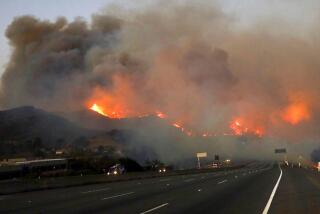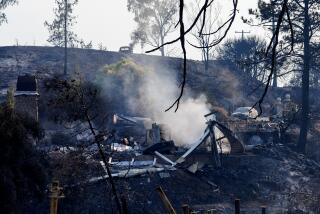Santa Ana disbands Fire Department in bid to rescue budget
The Santa Ana firehouse on Walnut Street is dotted with reminders of the department’s proud 128-year history.
A fire alarm telegraph system from 1924 takes up the back wall of the upstairs living room. Downstairs in the garage, the department’s first motorized pumping engine from 1921 is dwarfed by the modern truck, engine and ambulance.
On Monday, however, the Santa Ana Fire Department reached a final milestone. Officials gathered for a ceremony to mark the City Council’s decision to disband the department and have the Orange County Fire Authority handle fires and medical calls for Orange County’s second-largest city.
Many of the firefighters will continue to work in Santa Ana. But they will work for an agency that officials say will save the city — which faces a $30-million deficit — $10 million a year in expenses.
As cities grapple with the fallout of the recession, they are looking at relinquishing their independent fire departments to cut costs.
Another large city, Costa Mesa, is still considering a proposal by the Orange County Fire Authority to take over emergency services. El Segundo and Monterey Park have discussed joining the Los Angeles County Fire Department, with voters in El Segundo scheduled to vote on the matter in April.
Cities elsewhere in Southern California, in the Bay Area and in Sacramento have merged their fire departments with those in neighboring communities or with larger agencies, or are in talks to do so.
Officials have one overriding goal: Improving the economies of scale so they can cover their cities with lower administrative costs and sometimes fewer firefighters.
Public safety is generally the largest piece of the municipal budget and a fire department may constitute as much as 30% of a city’s general fund. More than police departments, fire departments lend themselves to a regional model because firefighters from different agencies tend to work together during major blazes, industrial accidents and wildfires, expert said.
By contracting out or merging the departments, cities can save on costs for payroll, training and fleet maintenance, and have access to resources such as helicopters and heavy rescue teams that small departments can’t afford. In some cases, outsourcing means cities can reduce staffing at their fire stations because the larger agency may already have stations nearby.
In Santa Ana, the move means the city’s daily fire station staffing will drop from 63 to 48. By contracting with the fire authority, the city gets out of its current labor contract with firefighters, which required higher staffing levels on engines than the fire authority plans to use.
The remaining firefighters from Santa Ana will be shifted to open positions elsewhere in the fire authority, which covers 22 other cities.
Santa Ana might lose some local control, but the cost savings proved too attractive during tough economic times.
“In a great economy, everyone wants to have their own service and their own local say. In a rotten economy, they look for efficiencies and economies,” said Stewart W. Gary, who studies fire and emergency services for the consulting firm Citygate Associates.
The decision to disband the independent Santa Ana Fire Department came as the city and its firefighters union were discussing significant cuts that officials would need to balance the budget. Both sides eventually realized that signing with the fire authority would provide cost savings to the city while protecting jobs.
Besides reducing staffing, the move will mean that the fire authority will take over services such as dispatching, payroll and training, with the costs spread among the authority’s member cities.
At a recent council meeting, Councilman Carlos Bustamante choked up as he thanked the Santa Ana firefighters for the years of Fourth of July parades and community Christmas tree lightings.
“It was something we kind of had to do,” Bustamante said in a telephone interview later. “You do it with a heavy heart, but you hope people understand we’re doing it for the good of the city.”
Even firefighters who favored the move have some regret.
Firefighter Rommel Laura, 26, grew up across the street from Station 5, where he now works. “For me, this is home because I get to help the people I grew up with, and I understand the way they live,” he said. But Laura said he and other young firefighters who wanted to buy homes and start families were tired of putting their plans on hold, plagued by worries about budget cuts and layoffs.
They see more job security with the county.
“We don’t want to be 10 years down the road and wondering if we’ll have a job,” Laura said.
To the older firefighters who have spent their entire careers at the department, the move stings more.
“Was it something that needed to be done? I don’t know. To me, it’s just a sad day,” said Fire Engineer Lou Fernandez, 52, who is also the mastermind behind the museum at Station 5. Since 1995, he has lovingly collected and curated the memorabilia.
“Hopefully, by the time I retire I’ll have it complete,” he said, pointing to empty shelves on a display cabinet in the firefighters’ sleeping quarters.
Some government reform advocates have for years been pushing municipalities to share government services like fire and public works. But during good times, cities have been unwilling to give up their firefighters, who are often held in high esteem in the community.
Although many cities remain committed to independent fire departments, the tough economic times have changed some attitudes.
In Los Angeles, the city’s financial crisis has resulted in sharp cuts in the Fire Department as officials made their first priority protecting the Los Angeles Police Department from reductions.
In the East Bay, the Alameda County Fire Department has absorbed the cities of Newark and Union City and is negotiating a contract with the city of Emeryville.
The cities of Fullerton and Brea still have their own departments but now share a fire chief. And Anaheim, Fullerton and Orange have studied merging their fire departments.
Santa Ana’s fire chief, Dave Thomas, said he thinks that if his city’s transition goes smoothly, smaller cities in the area may follow suit.
“I think everyone’s watching us,” he said.
More to Read
Sign up for Essential California
The most important California stories and recommendations in your inbox every morning.
You may occasionally receive promotional content from the Los Angeles Times.











